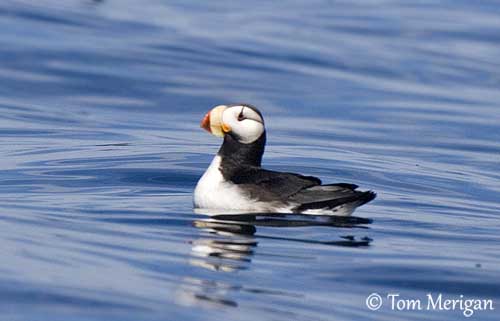
Fr: Macareux cornu
All : Hornlund
Esp : Frailecillo Corniculado
Ital : Pulcinella dal corno
Nd: Gehoornde Papegaaiduiker
Sd: Hornlunne
Photographer:
Tom Merigan
Tom Merigan’s Photo Galleries
Text by Nicole Bouglouan
Sources:
HANDBOOK OF THE BIRDS OF THE WORLD Vol 3 by Josep del Hoyo-Andrew Elliott-Jordi Sargatal - Lynx Edicions - ISBN : 8487334202
BirdLife International (BirdLife International)
All About Birds (Cornell Lab of Ornithology)
Birding Information
Horned Puffin
Fratercula corniculata
Charadriiforme Order – Alcidae Family
BIOMETRICS:
Length: 36-41 cm
Wingspan: 56-58 cm
Weight: 610 g
DESCRIPTION:
The Horned Puffin is very similar to the Atlantic Puffin, but it has larger bill and size.
The adult has black upperparts and white underparts.
On the head, forehead, crown, nape and chin are black. Face is white. We can see a black post-ocular stripe. There is a narrow, upright, elongated, triangular fleshy black horn above the eye, giving the species its name.
The large yellow bill is triangular with red tip. It is typically laterally compressed. There is a pale orange rictal rosette at gape. Mouth and spiny tongue are yellowish.
The eyes are dark brown to black. Legs and webbed feet can be orange or reddish, with black, sharp, curved claws.

Both sexes are similar, but the male has bigger and brighter bill, and it is slightly larger than the female.
They are duller in winter, and especially the bill.
The juvenile resembles adult in winter, but it is much smaller, with shorter, narrower and darker bill.
VOICE: SOUNDS BY XENO-CANTO
The Horned Puffin appears mostly silent outside the breeding season. However, it can become more vocal at the breeding colony, performing some vocal displays associated with threat and defence behaviour, but also as part of courtship and communication between parents and chicks.
During the disputes between two males, we can hear some growling “arrr”. But usually, puffins are less vocal than other Alcidae species.
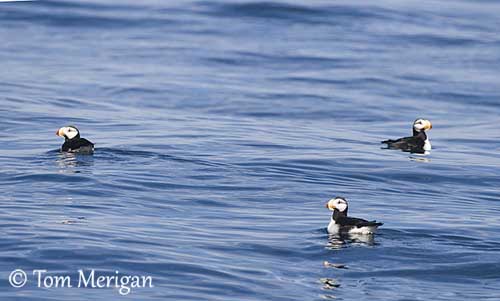
HABITAT:
The Horned Puffin spends the winter at sea, mainly offshore, within the open water areas of the breeding range to the edge of the continental shelf.
During the breeding season, it breeds on rocky offshore islands, rocky cliffs, boulder areas and slopes, rarely in burrows.
RANGE:
The Horned Puffin breeds off the coasts of Siberia, Alaska and British Columbia. It winters at sea but infrequently in open ocean and rarely beyond the northern half of the boreal zone.
Its winter range is closely related to sea surface temperatures and food availability, mainly pelagic fish.
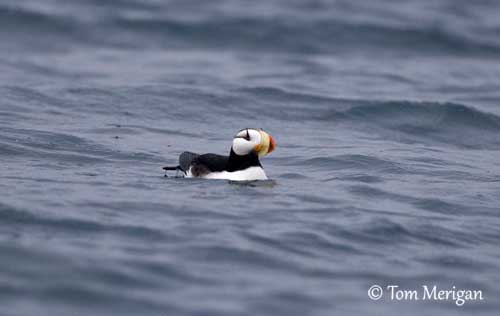
BEHAVIOUR:
The Horned Puffin feeds on wide diversity of fish species, but it also takes squid, crustaceans and marine worms (Polychaetes).
It catches its preys with the large bill. It may dive up to 40 metres depth for preys. It performs pursuit-diving and can carry several fishes at a time in its wide mouth.
The chicks are exclusively fed with fish brought by both parents.
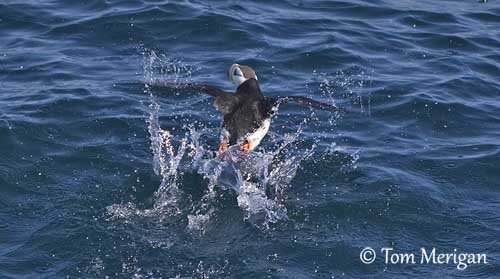
The Horned Puffin performs various displays used in threat, defence and courtship behaviour.
In threat displays, the bill is pointed towards the intruder and wide open. Bills can be locked together while both birds pull and twist during territorial disputes.
On the contrary, the “landing-display” with raised wings and cocked tail is more an appeasement behaviour.
“Billing” is part of courtship and can be performed during all the breeding season. This display often occurs when a bird lands near its mate at the nest-site, and it is used to maintain the pair-bonds. Both birds slap the sides of their bills together during 2-3 minutes.
Before the copulation, the male performs “head-jerking”. In all displays, the large, colourful bill plays and important role.
They are monogamous and mate for life. This gregarious species breeds in colonies on rocky islands and cliffs.
The Horned Puffin winters offshore in adjacent areas to breeding grounds, in open waters.
Dispersions occur after the breeding season in September-October. The northern populations from Bering Sea move southwards at least to Aleutians. The southern populations appear more sedentary with some S movements, even to Oregon and California.
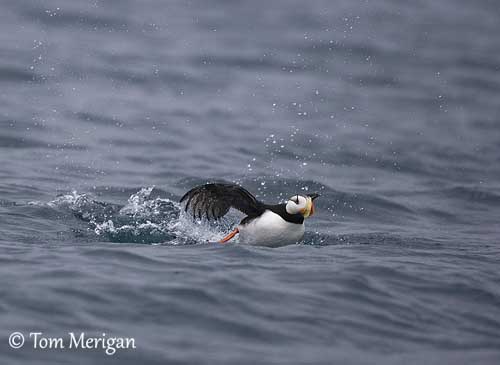
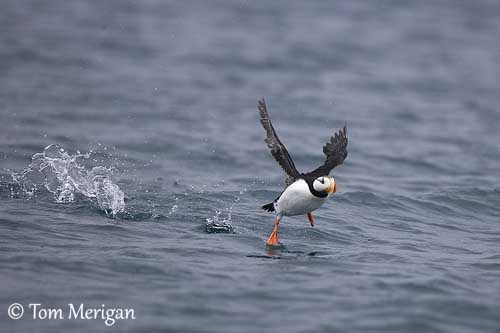
FLIGHT:
The Horned Puffin can fly but it is better swimmer than flier. It runs briefly over the water surface while beating its wings before to take off. The flight is rather laboured but strong, with rapid wingbeats. It flies high above the water.
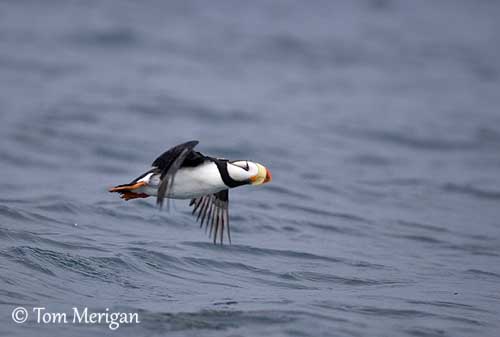
REPRODUCTION:
The Horned Puffin usually reoccupies the colonies between mid-May and early June. The peak of laying occurs from mid-June to mid-July. Fledging takes place in September.
This species breeds in small to large colonies. The nest is placed in rock crevice or crack in rock substrate, on cliff face, in cavities under boulders or talus slopes. It nests less commonly in burrows excavated in grassy island slopes.
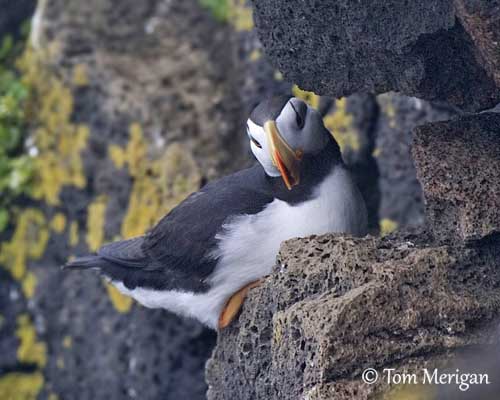
The female lays a singly egg on the bare floor, at end of crevice or cavity. There is sometimes a sparse lining of feathers or dry plant material. Both sexes incubate during 38-43 days. The downy chick is brownish above and yellowish below, with blackish bill, legs and feet. It is semi-precocial. Both parents care and feed it with fish.
According to the food resources, the chick fledges 40 days after hatching. It usually leaves the nest at night and flies alone out to sea. It is fully feathered. It will be sexually mature at 3-5 years old.
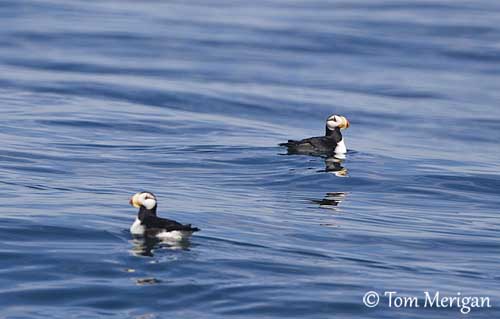
DIET:
The Horned Puffin feeds primarily on numerous fish species. It also takes squid, crustaceans and marine worms.
It performs pursuit-diving and can reach about 40 metres depth.
PROTECTION / THREATS / STATUS:
The Horned Puffin has large populations, although some declines or fluctuations can be reported.
But currently, the species is not globally threatened.
